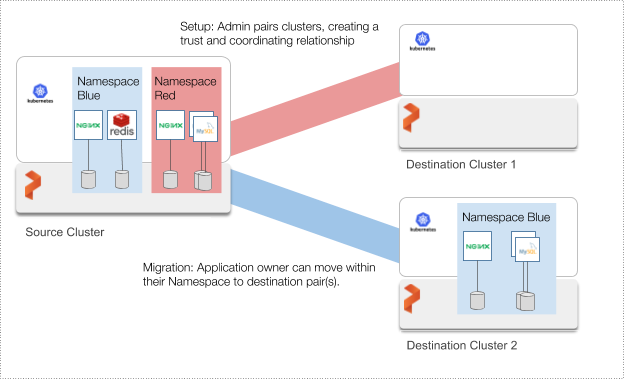Migration
Overview
The Migration with Stork on Kubernetes feature lets you migrate your applications and data between clusters. By using Migration with Stork on Kubernetes, you can get the benefits of portability for your data-rich workloads in a manner that works with Kubernetes. In a single command, Migration with Stork on Kubernetes moves Kubernetes-based application specifications, configuration, and Portworx volumes from one cluster to another.
Common use cases for Migration with Stork on Kubernetes include:
- Augment capacity: Free capacity on critical clusters by evacuating lower priority applications to secondary clusters.
- Blue-green test: Validate new versions of Kubernetes and/or Portworx using both application and its data. This is the same blue-green approach used by cloud-native application teams-- now available for your infrastructure.
- Dev/test: Promote workloads from dev to staging clusters in an automated manner. Thereby, eliminate the manual steps for data preparation that hurt fidelity of tests.
- Lift/Shift: Move applications and data from an on-prem cluster to a hosted AWS EKS or Google GKE. The reverse is also supported to repatriate, move applications on-prem.
- Maintenance: Decommission a cluster in order to perform hardware-level upgrades.
Pairing clusters
The first step in setting up migration with Stork on Kubernetes is to establish a trust relationship between a pair of clusters. Afterwards, an application namespace user can migrate applications and data within their namespace. An administrator can migrate on behalf of any Namespace or for all namespaces.
As an example, the administrator can setup a source cluster (left in the diagram below) to migrate to two destination clusters (right). Applications can then migrate to each destination cluster. In the example below, the Blue namespace migrates to Destination Cluster 1 and the Red to Cluster 2. Of course, multiple namespaces can migrate to a single destination cluster.

Migration volumes and applications
Once the cluster pair has been set up you can start migrating volumes and applications between the clusters.
On Kubernetes, Migration with Stork on Kubernetes leverages Namespaces so that teams can control how applications get migrated. The overall workflow then allows for teams to self-service their data needs, all within an administrator’s overall design.
Migration with Stork on Kubernetes on Kubernetes moves application objects, configuration, and data including:
- Kubernetes Objects: like Replication Controllers, StatefulSets, and Deployments which in turn includes the Pod specifications needed to run applications.
- Kubernetes Configuration: like ConfigMaps and Kubernetes Secrets needed for applications. (External secret stores such as Hashicorp Vault are not moved.)
- Portworx volumes: an incremental snapshot will be compressed and moved from the source cluster to the destination cluster
The following will not be moved as they are either cluster-specific, external to the cluster, or imprudent:
- Networking: external load balancers and overlay networking
- Service Accounts
- Kube-System Namespace: anything in kube-system namespace will not be moved.
Getting started
For instructions to setup cluster pair and perform migrations, proceed to one of the below sections.
📄 Data Migration
How to migrate volumes across clusters when running Portworx on other orchestrators.